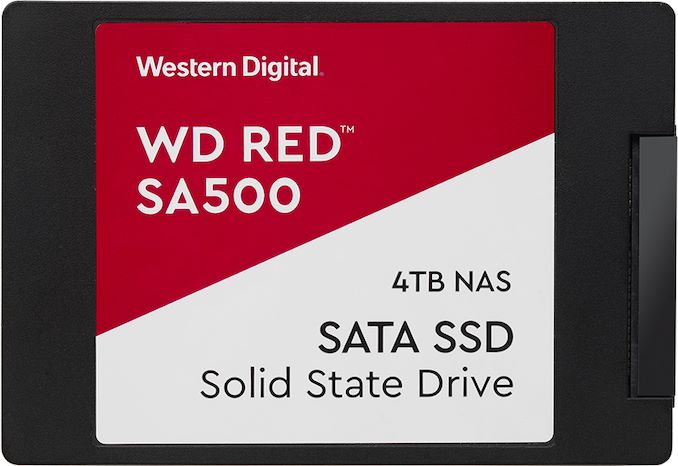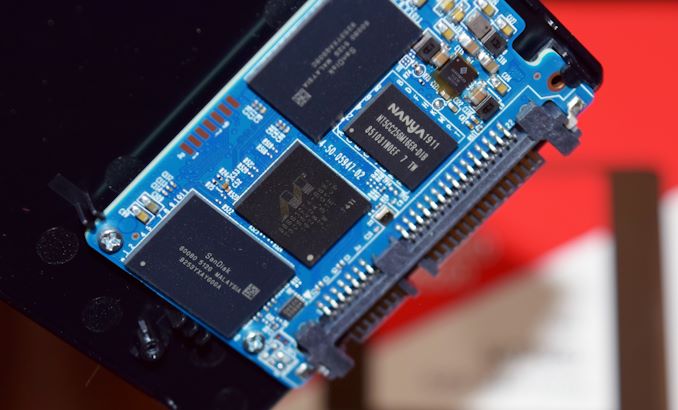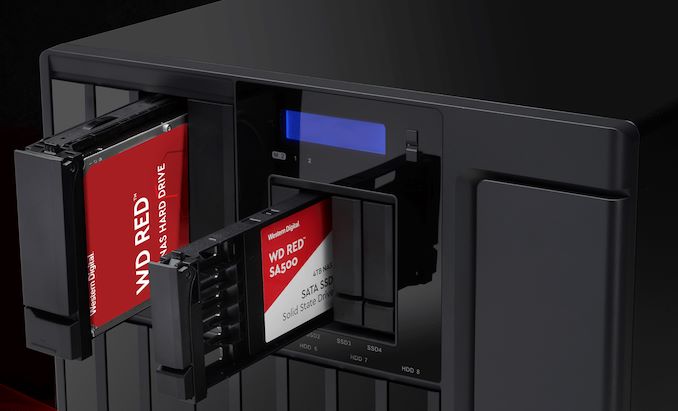Western Digital Launches WD Red SA500 Caching SSDs for NAS
by Anton Shilov on October 31, 2019 3:00 PM EST- Posted in
- SSDs
- Storage
- Western Digital
- WD Red

Western Digital has introduced its new WD Red SA500 family of specialized SSDs, which are designed for caching data in NAS devices. The drives are available in four different capacities from 500 GB to 4 TB to satisfy demands of different customers. To maximize their compatibility, the SSDs feature a SATA 6 Gbps interface and come in M.2-2280 or 2.5-inch/7-mm form-factors.
Now that many desktop PCs have either been replaced by laptops or are so small that they cannot house a decent number of capacious hard drives, NAS use is gaining traction among those individuals and small businesses who need to store fairly large amounts of data. To provide such customers high performance (which is comparable to that of internal storage), many NAS these days feature a 10GbE network adapter as well as a special bay (or bays) for a caching SSD. However, the vast majority of client SSDs on the market were not designed for pure caching workloads, which are more write-heavy than typical consumer workloads. Seagate with its IronWolf 110 was the first company to launch an SSD architected for NAS caching early this year and now Western Digital follows the suit with its WD Red SA500 family, which is broader than that offered by its rival.
While it's not being disclosed by the company, Western Digital’s WD Red SA500 SSDs are based on Marvell's proven 88SS1074 controller, and paired with the company’s 3D TLC NAND memory. When it comes to capacities, the new WD Red SA500 drives are available in two form-factors: M.2-2280 models offer 500 GB, 1 TB, and 2 TB capacities, whereas 2.5-inch/7-mm SKUs can store 500 GB, 1 TB, 2 TB and 4 TB of data.
Performance-wise, the WD Red SA500 offers up to 560 MB/s sequential read speeds, up to 530 MB/s sequential write speeds, and up to 95K/85K random read/write IOPS, which is in line with advanced client SATA SSDs. But the key difference between typical client drives equipped with the same controller and the WD Red SA500 is a special firmware optimized for more evenly mixed workloads and engineered to ensure longevity. By contrast, client SSDs are tailored mostly for fast reads.
As far as endurance is concerned, the WD Red SA500 SSDs are rated for 0.32 – 0.38 DWPD over a five-year warranty period, which is in line with that of modern desktop drives. This is admittedly not especially high for a drive that can fill itself in under an hour, but presumably Western Digital confident that the caching algorithms in modern NASes are not so aggressive that the drives will be extensively rewritten. Moreover, at the end of the day we are talking about consumer as well as SMB-class NASes, where the expected workloads are lower than with enterprise systems.
| The WD Red SA500 Caching SSDs for NAS | |||||
| Capacity | 500 GB | 1 TB | 2 TB | 4 TB | |
| Model Number | ? | ? | ? | ? | |
| Controller | Marvell 88SS1074 | ||||
| NAND Flash | 3D TLC NAND | ||||
| Form-Factor, Interface | M.2 | M.2-2280, SATA 6 Gbps | - | ||
| DFF | 2.5-inch/7-mm, SATA 6 Gbps | ||||
| Sequential Read | 560 MB/s | ||||
| Sequential Write | 530 MB/s | ||||
| Random Read IOPS | 95K | ||||
| Random Write IOPS | 85K | 82K | |||
| Pseudo-SLC Caching | ? | ||||
| DRAM Buffer | Yes, capacity unknown | ||||
| TCG Opal Encryption | ? | ||||
| Power Consumption | Avg Active | 52 mW | 60 mW | 60 mW | |
| Max. Read | 2050 mW | 2550 mW | 3000 mW | ||
| Max. Write | 3350 mW | 3750 mW | 3800 mW | ||
| Slumber | 56 mW | 56 mW | |||
| DEVSLP | 5-7 mW | 5-12 mW | |||
| Warranty | 5 years | ||||
| MTBF | 2 million hours | ||||
| TBW | 350 | 600 | 1300 | 2500 | |
| DWPD | 0.38 | 0.32 | 0.35 | 0.34 | |
| UBER | 1E10^17 | ||||
| Additional Information | Link | ||||
| MSRP | M.2 | $72 | ? | $297 | - |
| DFF | $75 | ? | ? | $600 | |
Western Digital’s WD Red SA500 SSDs are currently available directly from the company, with broader availability expected in November. The cheapest 500 GB model costs $72 – $75 depending on the form-factor, the top-of-the-range M.2 2 TB SKU is priced at $297, whereas the highest-capacity 4 TB 2.5-inch model carries a $600 price tag.
Related Reading:
- Seagate Introduces IronWolf SSD for NAS
- QNAP Launches Mustang-200 Compute Accelerator for Network Attached Storage
- WD Adds Helium-Filled 10 TB NAS HDDs to WD Red, WD Red Pro Lineups
- Western Digital Introduces Its First Helium-Filled HDDs for Consumer Applications
Source: Western Digital














24 Comments
View All Comments
AnarchoPrimitiv - Saturday, November 2, 2019 - link
SFP is a terrible way to go for a home 10Gig network... You can't run DAC through your walls and even if you did SMF or MMF, transceivers are expensive. 10GBase-T is the way to go since CAT6a/CAT7 is cheap (I got 1000ft spool for under $200), and that's what I have. The Asus XG-U2008 10GBase-T switch is $200 or under and The Aquantia 10GBase-T NICs are $100 or under. Heck, even the Intel X710-T4 (4x 10gbase-t ports) that I have in my NAS/Server for an aggregated 40Gbit backbone is getting close or below $500 now and my Netgear XS728T switch is seen for under $1000. But anyone can make a simple 10GBase-T home network for $300 or under and one you have that kind of speed, everyone agrees that it's worth itsvan1971 - Thursday, October 31, 2019 - link
$85 ? Link please.name99 - Thursday, October 31, 2019 - link
At least for some of us, the issue is less cost than applicability.There is no home-appropriate equipment -- just a few RJ-45 ports rather than 8+, small rather than rack-sized, no loud jet turbine cooling, no complicated config, no SFP, ...
rrinker - Friday, November 1, 2019 - link
I do plan to do something greater than GbE when I build a new storage server, but in reality, I only need the faster speed in two places - the server itself, to then support multiple GbE streams off of it, and my primary desktop which is where I tend to do most of my downloading - to then copy up to the server (yes, I could just download right to the server...). Everything else that happens on the network - GbE is not a bottleneck, by any stretch. Nice thing is, the server and my primary desktop and the switch all sit right next to another, so needing some sort of fiber cable or other than a regular Ethernet cable is no big deal, they can all be short.wr3zzz - Thursday, October 31, 2019 - link
SDD in NAS are for caching. The NAS won't send any large files there, just the tiny ones. Tiny files have tiny read/write speed vs. sequential.imaheadcase - Friday, November 1, 2019 - link
The reason nothing takes off in the consumer market is simply not the hardware, its the wiring. Unless you are the few people who can buy a brand new home, most homes don't have the required wiring, or enough wiring, or not wired correctly to even use faster speeds.This isn't some future in a sci-fi movie, the reality is most people rent, or if own a home its old.
So the incentive to crank out faster network equipment at a lower price just is not worth it.
To illustrate my point, a new 60 home subdivision nearby has Cat 5e, 1 cable to main bedroom, 1 cable upstairs den, 1 cable to kitchen because apparently developers think everyone still had phones on wall in kitchen still.
29a - Friday, November 1, 2019 - link
The majority of people own homes not rent them.https://www.nmhc.org/research-insight/quick-facts-...
AnarchoPrimitiv - Saturday, November 2, 2019 - link
Are you kidding me? Asus has the XG-U2008 10GBase-T switch for $200 or less and aquantia has 10GBase-T NICs (as well as Asus which is based upon Aquantia's IC) for $100 or less. I have a home 10gbase-t network network and even my switch which is a 28 Port 10GBase-T switch (Netgear XS728T) is available on sale for under $1000. CAT6a cable is cheap as dirt and even CAT7 is too which is what I wired my house in.10GBase-T networks, especially small ones where the only 10gbit connections are between a NAS/server, a switch and a single PC can easily be done for $300 or under.
If you think they're unnecessary, think again with 4K streaming content becoming more and more commonplace. Also, Internet is getting faster and faster for cheaper. I have symmetrical Gigabit (980Mbps download/975Mbps upload) for $70/month and I hear talk of 2Gig, 5Gig, and even 10Gig coming unto the consumer space sooner than later.
CheapSushi - Wednesday, November 6, 2019 - link
What do you mean? There are affordable 10G NICs available now, even 5G and 2.5G. You can direct connect or even make software defined networking switches with the NICs. Seems like people would rather wait for cheap 999999 port 10G switches.wr3zzz - Thursday, October 31, 2019 - link
Should I wait for NVMe caching SSD for NAS or SATA is more than enough?